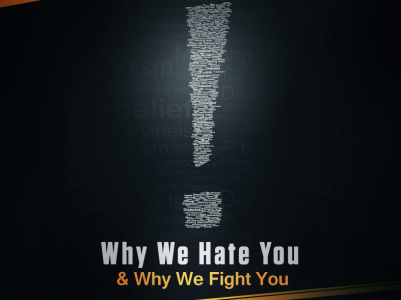
ISIS ‘caliphate’ fades but social media empire remains online
Since the U.S. declared its War on Terror 16 years ago, it has achieved a number of battlefield successes against its main terrorist adversaries, al Qaeda and more recently ISIS. U.S. operations in South and Central Asia have crippled core al Qaeda’s capabilities, while a U.S.-led international coalition has thwarted ISIS’ ambitions to build a caliphate and put the group on the run across Syria and Iraq.
However, the fight against terrorism is not relegated to territorial gains; defeating the spread of jihadist ideology and propaganda represents an even more daunting task that the U.S. and its partners must confront to ultimately defeat this threat.
Both al Qaeda and ISIS have proven adept at harnessing various platforms, including the internet, print, and radio, to disseminate their messages. Whether through passionate religious sermons and high-definition recruitment videos posted online, published pamphlets and magazines distributed by hand, or encrypted communications transmitted through social media apps, these groups have managed to direct their ideas towards a wide audience.
“What both these groups and other groups have understood is that they need as many weapons in the marketplace as they can, which means they need as many touch points that they can get to appeal to a young person,” says Farah Pandith, Cipher Brief expert and former Special Representative to Muslim Communities at the U.S. State Department. “What this means is that their narrative is in surround sound.”
Al Qaeda was the first jihadist group to launch a concentrated media wing, and its global influence continues to resonate amongst current extremist movements. Currently, each al Qaeda affiliate across the globe boasts its own media arm that disseminates material on its behalf.
“The model for all jihadi media groups is Al Qaeda Central’s Al-Sahab media organization,” writes Steve Stalinsky, Executive Director of the Middle East Media Research Institute.
“Al-Sahab’s mission was to disseminate the organization’s views and policies, promote global jihad, and inspire homegrown terrorism,” he says.
But despite the achievements of al Qaeda’s media operation, the group that has taken the spotlight in the terrorist propaganda sphere is ISIS.
“Once the Islamic State was declared in late June 2014, ISIS’ media production quickly surpassed al Qaeda’s,” says Stalinsky, who described the breadth of ISIS’ media machine, including its own radio and news streaming services, a variety of publications, and an independent company specifically designated to produce non-Arabic content.
ISIS has become particularly skilled at utilizing social media websites, such as Twitter and Facebook, and encrypted communication applications, such as Telegram, to recruit new members and lure them to either travel abroad and fight on their behalf, or conduct acts of terror in their home countries. In essence, ISIS plays on the jihadist storyline, which portrays the West as an enemy of Islam and claims that the West is trying to impose its will on Muslim lands. Only by participating in jihad against the West will Muslim lands be saved, an Islamic caliphate created, and the world reach its phase of final salvation.
Exploiting its vast media capabilities, ISIS has managed to convert this grand message into targeted appeals that resonate on an individual basis, attracting a variety of people to its cause.
“Behind all of the slick visuals and cinematic sophistication of ISIS propaganda, exhorting lone wolf attacks is ISIS’s stickiest idea: That whatever your grievance—no matter what it is—killing for ISIS will meet your need,” wrote Patrick Skinner in The Cipher Brief.
In addition, an integral part of ISIS’ and al Qaeda’s draw stems from their focus on running contemporary propaganda campaigns where they formulate their messages around today’s most pressing issues.
“These groups are consistently current, which means that they are watching and listening, they are cultural listeners, and that they understand what’s happening in the foreign policy sphere as well as in the cultural and political sphere,” Pandith told The Cipher Brief.
“They’re taking advantage of everything that’s happening in real time and are understanding Generation Z and millennials, and they are targeting their messages and the way they manifest that message, so that it is appealing to the demographic they’re trying to recruit.”
The U.S. government has spearheaded initiatives to combat terrorist propaganda, albeit with mixed results. Within the U.S. government, the Bureau of Counterterrorism and Countering Violent Extremism, housed at the State Department, has implemented several programs where the U.S. works alongside foreign partners to strengthen their law enforcement and judicial capabilities and enhance their counter-messaging strategies.
Furthermore, the U.S. government has enlisted social media companies, such as Facebook and Twitter, to identify potential terrorists and remove violent content from their websites. In 2016, Twitter announced it had disabled 235,000 accounts it believed promoted terrorism.
But, while important, these government efforts have their limitations. In fact, according to Pandith, the most important steps to counter the jihadist ideology should be taken at the local community level.
“Young people in Generation Z and millennials are moved by their own peer group, so, the messengers must be their own peer group,” says Pandith. “They’ve got to be influencers from that demographic in a very nuanced way.”
Al Qaeda and ISIS continue to disseminate their jihadist ideologies and publish daily propaganda through the multitude of platforms available to them. Despite the accomplishments of the U.S. and its allies in fighting terrorists, the battle for people’s hearts and minds is far from over.
Source: The Cipher Brief





